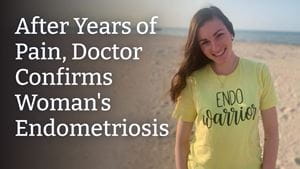
More than 10 percent of women suffer from endometriosis. Cara, a woman in her 20s, shares her story of pain – and the relief that followed.
Cara Pulumbieri had been experiencing unbearable pain and cramping in her lower abdomen for years. At the age of 21, many doctors would not take her seriously.
“I started having symptoms when I was 17,” Cara said. “It just got progressively worse over the next year. So I saw a OBGYN and I said, ‘I think I have endometriosis based on the symptoms.’ They told me, ‘You don’t have that. You’re okay. Everybody has period pain. Don’t worry until there is something to worry about.’”
Cara left her office visit and was excited, but said her pain became even worse over the next year. The pain led her to return to another OBGYN at the same practice.
“She never said I didn’t have it, but she didn’t do anything about it,” Cara said.
“From the time I was a toddler, all I ever wanted was to be a mom,” Cara said. “When I started having pain, I knew something was wrong, but nobody seemed to think that it was wrong.”
After seeing several different doctors and being prescribed five different birth controls, Cara was at a loss.
“I literally was in tears, crying to God in the car and looking for help because we had nothing,” said Margaret Pulumbieri, Cara’s mother. “We had nowhere else to turn, to our knowledge. Being every day, I couldn’t stand it anymore. Literally that day that I prayed, I ran into a patient of Dr. Mohammad Mahmoud’s – first thing in the morning – and they were singing his praises. And I was like, ‘I’ve got to see this doctor.’”
“When I talked with him, he was finishing my sentences,” Margaret said. “He knew, he had heard this so many times that he knew what we were going through and thought he could help us.”
Mohammad Mahmoud, MD, is an OBGYN specialist who frequently sees patients going through this sort of pain.
“Unfortunately, I see many women and ladies her age in the same situation,” Dr. Mahmoud said. “Years after struggle, years after pain, we perform surgery on them and we find that they have endometriosis. Usually the best treatment is to excise the endometriosis to make them feel better.”
It is important to diagnose and treat endometriosis early on.
“The earlier we do the surgery, the better, because the longer you have it and it’s not treated, it’s going to progress and it’s going to cause scarring inside the body, the organs start to adhering to each other, and then the fallopian tube gets blocked and other things can happen,” Dr. Mahmoud said.
“At a certain point, if we are late in the diagnosis, let’s say after a few years, and somebody does a surgery, it’s a harder surgery. At that point, many women develop what we call chronic pain syndrome. So even if we remove the disease at that point, the pain is not going to completely go away. So even if you remove all the disease at that point, people still have chronic pain.”
Cara did not want to switch doctors because she felt as though it would hurt her doctor’s feelings.
“I would have switched 100 times to get to [Dr. Mahmoud] because you need to find somebody who listens to you,” Cara said. “When I had my first appointment with him and he wasn’t just saying, ‘Oh, uh huh, uh huh, yeah, that’s normal,’ that’s what I was like, ‘Okay, he gets it.’ I knew that if this is something that I had, this is something that I needed to get it taken care of sooner so I could have better results.”
Cara underwent surgery to remove the endometriosis. Four months after her surgery, she has not had any pain.